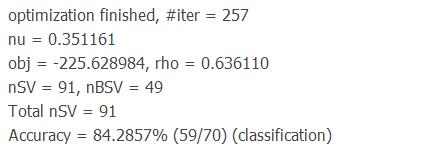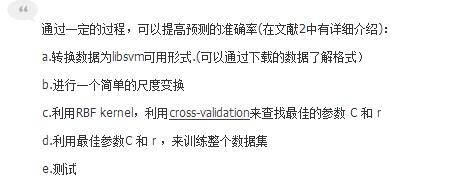如何利用python使用libsvm
Posted
tags:
篇首语:本文由小常识网(cha138.com)小编为大家整理,主要介绍了如何利用python使用libsvm相关的知识,希望对你有一定的参考价值。
准备工具
libsvm软件包;
电脑;
步骤操作
把包解压在C盘之中,如:C:\\libsvm-3.18;
用libsvm自带的脚本grid.py和easy.py,需要去官网下载绘图工具gnuplot,解压到c盘;
进入c:\\libsvm\\tools目录下,用文本编辑器(记事本,edit都可以)修改grid.py和easy.py两个文件,找到其中关于gnuplot路径的那项,根据实际路径进行修改,并保存;

例子举例

常用接口

提高预测的准确率

一:libsvm包下载与使用:
LIBSVM是台湾大学林智仁(Lin Chih-Jen)副教授等开发设计的一个简单、易于使用和快速有效的SVM模式识别与回归的软件包,他不但提供了编译好的可在Windows系列系统的执行文件,还提供了源代码,方便改进
1.
把包解压在C盘之中,如:C:\\libsvm-3.18
2.
因为要用libsvm自带的脚本grid.py和easy.py,需要去官网下载绘图工具gnuplot,解压到c盘
3.
进入c:\\libsvm\\tools目录下,用文本编辑器(记事本,edit都可以)修改grid.py和easy.py两个文件,找到其中关于gnuplot路径的那项,根据实际路径进行修改,并保存
4python与libsvm的连接(参考SVM学习笔记(2)LIBSVM在python下的使用 )
a.打开IDLE(python GUI),输入
>>>import sys
>>>sys.version
如果你的python是32位,将出现如下字符:
‘2.7.3 (default, Apr 10 2012, 23:31:26) [MSC v.1500 32 bit (Intel)]’
这个时候LIBSVM的python接口设置将非常简单。在libsvm-3.16文件夹下的windows文件夹中找到动态链接库libsvm.dll,将其添加到系统目录,如`C:\\WINDOWS\\system32\\’,即可在python中使用libsvm
b.如果你是64位的请参考文献,请参考上述连接。
5.执行一个小例子

import os
os.chdir('C:\\libsvm-3.18\\python')#请根据实际路径修改from svmutil import *y, x = svm_read_problem('../heart_scale')#读取自带数据m = svm_train(y[:200], x[:200], '-c 4')
p_label, p_acc, p_val = svm_predict(y[200:], x[200:], m)

##出现如下结果,应该是正确安装了
optimization finished, #iter = 257
nu = 0.351161
obj = -225.628984, rho = 0.636110
nSV = 91, nBSV = 49
Total nSV = 91
Accuracy = 84.2857% (59/70) (classification)
二几个简单的例子
从cjlin/papers/guide/data/下载实验数据集。并且将数据集拷贝到C:\\libsvm-3.18\\windows下(因为之后我们需要利用该文件夹下的其他文件,这样比较方便,当然之后你用绝对地址也可以了)
建立一个py文件,写下如下代码:
例1:

import os
os.chdir('C:\\libsvm-3.18\\windows')#设定路径from svmutil import *y, x = svm_read_problem('train.1.txt')#读入训练数据yt, xt = svm_read_problem('test.1.txt')#训练测试数据m = svm_train(y, x )#训练svm_predict(yt,xt,m)#测试

执行上述代码,精度为:Accuracy = 66.925% (2677/4000) (classification)
常用接口
svm_train() : train an SVM model#训练
svm_predict() : predict testing data#预测
svm_read_problem() : read the data from a LIBSVM-format file.#读取libsvm格式的数据
svm_load_model() : load a LIBSVM model.
svm_save_model() : save model to a file.
evaluations() : evaluate prediction results.
- Function: svm_train#三种训练写法
There are three ways to call svm_train()
>>> model = svm_train(y, x [, 'training_options'])
>>> model = svm_train(prob [, 'training_options'])
>>> model = svm_train(prob, param)
有关参数的设置(read me 文件夹中有详细说明):
Usage: svm-train [options] training_set_file [model_file]
options:
-s svm_type : set type of SVM (default 0)#选择哪一种svm
0 -- C-SVC (multi-class classification)
1 -- nu-SVC (multi-class classification)
2 -- one-class SVM
3 -- epsilon-SVR (regression)
4 -- nu-SVR (regression)
-t kernel_type : set type of kernel function (default 2)#是否用kernel trick
0 -- linear: u'*v
1 -- polynomial: (gamma*u'*v + coef0)^degree
2 -- radial basis function: exp(-gamma*|u-v|^2)
3 -- sigmoid: tanh(gamma*u'*v + coef0)
4 -- precomputed kernel (kernel values in training_set_file)
-d degree : set degree in kernel function (default 3)
-g gamma : set gamma in kernel function (default 1/num_features)
-r coef0 : set coef0 in kernel function (default 0)
-c cost : set the parameter C of C-SVC, epsilon-SVR, and nu-SVR (default 1)
-n nu : set the parameter nu of nu-SVC, one-class SVM, and nu-SVR (default 0.5)
-p epsilon : set the epsilon in loss function of epsilon-SVR (default 0.1)
-m cachesize : set cache memory size in MB (default 100)
-e epsilon : set tolerance of termination criterion (default 0.001)
-h shrinking : whether to use the shrinking heuristics, 0 or 1 (default 1)
-b probability_estimates : whether to train a SVC or SVR model for probability estimates, 0 or 1 (default 0)
-wi weight : set the parameter C of class i to weight*C, for C-SVC (default 1)
-v n: n-fold cross validation mode
-q : quiet mode (no outputs)
三提高预测的准确率:
通过一定的过程,可以提高预测的准确率(在文献2中有详细介绍):
a.转换数据为libsvm可用形式.(可以通过下载的数据了解格式)
b.进行一个简单的尺度变换
c.利用RBF kernel,利用cross-validation来查找最佳的参数 C 和 r
d.利用最佳参数C 和 r ,来训练整个数据集
e.测试
再看例子1:
1.进入cmd模式下,输入如下代码,将现有数据进行适度变换,生成变换后的数据文件train.1.scale.txt

参数说明:
-l 变换后的下限
-u 变换后的上限
-s 参考上文
2执行以下代码

import os
os.chdir('C:\\libsvm-3.18\\windows')#设定路径from svmutil import *y, x = svm_read_problem('train.1.scale.txt')#读入训练数据yt, xt = svm_read_problem('test.1.scale.txt')#训练测试数据m = svm_train(y, x )#训练svm_predict(yt,xt,m)#测试

精确度为Accuracy = 95.6% (3824/4000) (classification)。
可见我们只是做了简单的尺度变换后,预测的正确率大大提升了。
3通过选择最优参数,再次提高预测的准确率:(需要把tools文件下的grid.py拷贝到'C:\\libsvm-3.18\\windows'下)

import os
os.chdir('C:\\libsvm-3.18\\windows')#设定路径from svmutil import *from grid import *rate, param = find_parameters('train.1.scale.txt', '-log2c -3,3,1 -log2g -3,3,1')
y, x = svm_read_problem('train.1.scale.txt')#读入训练数据yt, xt = svm_read_problem('test.1.scale.txt')#训练测试数据m = svm_train(y, x ,'-c 2 -g 4')#训练p_label,p_acc,p_vals=svm_predict(yt,xt,m)#测试

执行上面的程序,find_parmaters函数,可以找到对应训练数据较好的参数。后面的log2c,log2g分别设置C和r的搜索范围。搜索机制是以2为底指数搜索,如 –log2c –3 , 3,1 就是参数C,从2^-3,2^-2,2^-1…搜索到2^3.
搜索到较好参数后,在训练的时候加上参数的设置。
另外,读者可以自己试试数据集2,3.
如何在 python 中使用 libSVM 计算精度、召回率和 F 分数
【中文标题】如何在 python 中使用 libSVM 计算精度、召回率和 F 分数【英文标题】:How to calculate precision, recall and F-score with libSVM in python 【发布时间】:2013-05-31 10:43:44 【问题描述】:我想在 Python 中使用 libsvm 计算 precision、recall 和 f-score,但我不知道如何。我找到了this site,但我不明白如何调用该函数,如果你能通过示例帮助我。
【问题讨论】:
【参考方案1】:您可以利用 scikit-learn,它是 Python 中机器学习的最佳软件包之一。它的 SVM 实现使用libsvm,您可以计算出精度、召回率和 f-score,如下面的 sn-p 所示:
from sklearn import svm
from sklearn import metrics
from sklearn.cross_validation import train_test_split
from sklearn.datasets import load_iris
# prepare dataset
iris = load_iris()
X = iris.data[:, :2]
y = iris.target
X_train, X_test, y_train, y_test = train_test_split(X, y, test_size=0.2)
# svm classification
clf = svm.SVC(kernel='rbf', gamma=0.7, C = 1.0).fit(X_train, y_train)
y_predicted = clf.predict(X_test)
# performance
print "Classification report for %s" % clf
print
print metrics.classification_report(y_test, y_predicted)
print
print "Confusion matrix"
print metrics.confusion_matrix(y_test, y_predicted)
这将产生类似这样的输出:
Classification report for SVC(C=1.0, cache_size=200, class_weight=None, coef0=0.0, degree=3, gamma=0.7,
kernel=rbf, max_iter=-1, probability=False, shrinking=True, tol=0.001,
verbose=False)
precision recall f1-score support
0 1.00 1.00 1.00 9
1 0.90 0.69 0.78 13
2 0.64 0.88 0.74 8
avg / total 0.86 0.83 0.84 30
Confusion matrix
[[9 0 0]
[0 9 4]
[0 1 7]]
当然,您可以使用您提到的libsvm tools,但它们仅适用于二进制分类,而scikit允许您使用多类。
【讨论】:
您正在加载什么数据集?例如,如果我的数据集在文本文件中,如何使用它们? 在示例中,我使用了一个名为 iris 的预定义数据集,它带有scikit-learn。对于特定数据集,您需要将文本数据转换为 numpy 矩阵。以上是关于如何利用python使用libsvm的主要内容,如果未能解决你的问题,请参考以下文章